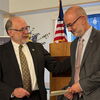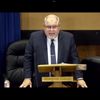Leadership change after 23 years at Maine Children's Home
 Photo / Russ Dillingham
Sharon Abrams, who retired Dec. 31 after 23 years as executive director of the Maine Children's Home for Little Wanderers, is flanked by her successor, Richard Dorian, who has extensive leadership experience with nonprofits.
Photo / Russ Dillingham
Sharon Abrams, who retired Dec. 31 after 23 years as executive director of the Maine Children's Home for Little Wanderers, is flanked by her successor, Richard Dorian, who has extensive leadership experience with nonprofits.
Recently, a woman in her 40s approached Maine Children's Home for Little Wanderers' outgoing executive director, Sharon Abrams, to congratulate her on her imminent retirement. Abrams stepped down after 23 years as director and 41 years with the nonprofit.
“The woman said, 'You probably don't remember me.' And in about five seconds, Sharon said her name and that she was from Palmyra and remembered all these details about her from 27 years ago,” recounts Richard Dorian, the nonprofit organization's new executive director.
As a pregnant teenager, the woman had been a client of the organization, taking advantage of a program for teen parents. She finished her high school education through the nonprofit's alternative education program, graduated from college and is now a teacher; all four of her children have also graduated from college.
“That's a powerful story to share,” says Dorian.
Stories like that form the essence of Abrams' 41 years with the organization.
“Talking about teen parents, I've been around all the years that program has been operating,” Abrams says. “There's nothing like running into somebody, on campus or in the grocery store, whom you knew 25 years ago and you find out that they finished high school and college and now have a master's degree and their children are in college, too. That speaks to what our mission is — to provide the tools that give people hope and a better quality of life.”
Since 1974, Abrams, who retired Dec. 31, has been instrumental in the agency's expansion of programs as it aims to meet needs that she says continue to grow. As executive director since 1992, she's seen the nonprofit through challenging economic times, including several recessions and, in turn, through growth and change.
“We're unique in how much programming we have to offer on one campus,” says Abrams. “That was one of my dreams — to have a one-stop shop, so to speak, so that we could meet people's needs here or refer them to other programs.”
Keeping a nonprofit alive
The business of running a nonprofit hinges on the generosity of individual and corporate donors, foundations, funding agencies and volunteers.
Tools of the trade include communication and collaboration. Picking up the phone, hand-writing notes, arranging face-to-face meetings, Abrams says, are powerful ways to reach potential donors and grant organizations.
“You should see Sharon's Rolodex,” says Dorian, via conference call from Abrams' office during their month-long transition. “It's crammed with business cards. That's an image of her role here and her history and longevity. She's been in Waterville her whole life and knows the majority of people here in Kennebec County. Her impact, influence and connections — so many of the things that have happened here in the evolution of the organization — is through her grace and connections. She can pick up the phone and call so many people; she knows the state's top leaders.”
Six years ago, Abrams says she and the board realized they needed to increase their connectivity with potential clients and donors through a broad community public relations push. They hired Nancy Marshall Communications, a PR firm whose owner, Nancy Marshall, has been instrumental in publicizing what “she tagged 'the best-kept secret in Maine,'” says Abrams. “We're now on TV and radio, and in print. They designed our Facebook page. It's a whole new world now. Twenty years ago, I think we felt this kind of publicity was bragging. We weren't very good talking about ourselves and spreading the word.”
Media exposure has been essential to reach a broad-based audience.
“It's vital that we keep expanding the frontiers of how we communicate with people, especially with younger people, and as new technology offers so many ways to reach people easily and quickly,” says Dorian. For example, “Recently, with our Christmas program, we were running low filling [gift] packages for children all over the state. But with just a few phone calls and emails, and putting the call out on Facebook, our website, and radio and TV, people from all over the country responded to help meet every need. It's extraordinary how powerful media and social media are for reaching people and inviting them to be partners.”
The Maine Children's Home was founded in 1899 in Augusta as an orphanage. In 1915, the orphanage closed, but the home continued its adoption program and expanded its support services. In 1962, the Maine Children's Home and the Maine branch of The New England Home for Little Wanderers — the state's two longest-operating children's agencies — merged under the Maine Children's Home for Little Wanderers name and the headquarters moved to Waterville.
A good fit to lead
Abrams was a newly minted college graduate when she went to work as a long-term substitute teacher at Waterville High School. The Maine Children's Home for Little Wanderers was developing a program for pregnant and parenting teens, in collaboration with the high school and its school board; Abrams was identified as a good fit to lead the program.
“For the time, I think both the home and the school board were way ahead of the curve in terms of understanding what kids need and what it takes to collaborate,” says Abrams. “There wasn't much collaboration back then. There can be a tendency for nonprofits to work in silos. We worked well together on issues we saw from different directions.”
The teen parents themselves were key in driving the initiative: “They were coming to us saying, 'I want to take a prenatal class, but I'm uncomfortable because the classes are all married couples and I'm single,'” Abrams recalls. “After that, they said, 'I need parenting classes.' Then they came back saying, 'I need to finish high school.'”
When she came on, the agency was on Main Street in a space formerly occupied by a boys club. To accommodate growing programs, the agency moved to a donated three-story building at 34 Gilman St.
Abrams started as a part-time tutor, became a licensed social worker, went to work in the adoption program, took on fundraising and finances as the assistant executive director, then became executive director in 1992.
Over the years, Abrams says, the success of the programs uncovered greater need. Space continued to be an issue.
“We had enough money to survive, but the building was too small to exist with the programs we had,” she says.
In 2001, the agency launched its first capital campaign in order to purchase a five-building campus that was the former Criminal Justice Academy on 93 Silver St. in Waterville.
“That was huge,” says Abrams. “It was the first time we did a capital campaign, even though the organization, at that point, was well over 100 years old. We needed to raise at least $1.5 million.”
Former U.S. Sen. George Mitchell served as the campaign's honorary chairman. Philanthropists Harold and Dorothy “Bibby” Alfond helped the agency exceed its goal by $500,000, which became the core of the campus maintenance fund, today yielding about $30,000 in annual interest for maintenance projects. The participation of the Alfond family also illustrates the importance of personal relationships, says Abrams: Bibby Alfond's periodic visits to the children's center helped draw attention and additional donations.
The move, which occurred in 2002, also ramped up the home's operational budget. The Gilman Street location had about 10 staffers and an operating budget of $450,000. Today, those numbers have about quadrupled, with approximately 40 staffers, depending on the season, and an operating budget of $1.9 million. Programs include outpatient mental health counseling (over 200 clients annually), case management services (about 100 clients) and a nationally accredited early care and education program (55 children, infant-school age). The teen parent alternative school program, providing one year of academic education as well as prenatal and parenting classes, accommodates 20 students on average and occupies a building that also houses the city's alternative school program, which accommodates another 20 to 25 students. On average, the adoption program places 10 to 14 children in a year.
“We're still lean and efficient,” says Abrams. “We keep our budget down. Salaries and benefits are one of our biggest costs. We now hire staff with master and bachelor degrees, and it costs more to do so.”
“Lean and efficient” is all the more essential when the economy plunges. As executive director, Abrams has seen the agency through three recessions.
Abrams cites the latter as an example of how she and her board powered through tough times.
Dorian says the agency's high standards and focus on improvement engender trust that allows it to thrive through both good and trying times.
Dorian's nonprofit background includes 27 years of leadership and management experience, including 15 years as executive director at LEAP (Life Enrichment Advancing People), and an extensive background in community relations, strategic planning, development and fundraising.
“This organization hasn't tried to just do the same old thing,” he says. “It's always focused on how to do better with the least amount of resources. ”










Comments